After failing to make it to Ross's Garden City Formation localities in June because of the huge western snowpack and late melt, we carved out a week in October to go, to try to get some critical resampling of important horizons done. It was hectic - we left one day after a nine institution collaborative NSF digitization grant that I was lead PI on and we got back the day before Sarah and I had to fly to Seattle for GSA. It was also the fifth time this year I've done the dreaded out and back drive across the middle part of the country. The trip was generally successful, though, and a nice break in the middle of semester.
The first night we got as far as Cheyenne, Wyoming. This is the nomal stopping point when going the northern I-80 route toward Idaho. It's a long drive, but you pick up an hour on the time change and so can get into Cheyenne in time to get dinner. It turned out the downtown restaurant by the railway station that used to be a brew pub, then wasn't a brew pub, is newly a brew pub once more. Further, it's one of these newfangled deals where the beer is dispensed gas station style. You get a beer card and use it do draw as much as you like of whatever variety you want, then pay at the end. This has overtones of danger, but a combination of no one to egg me on and "beer" that tasted mostly like rancid bongwater kept things well in check. The menu was limited and okayish. Not a must stop, still looking for something really decent in Cheyenne.
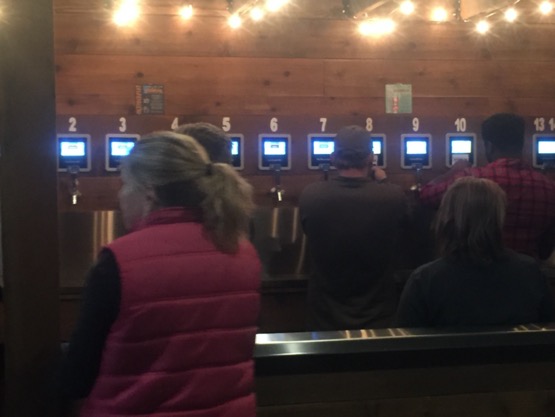
The "fill 'er up" beer dispensary seemed promising but, sadly, the beer was not.
Talia joined us in Cheyenne in the morning (she drove up from Boulder) and we had breakfast. A local newspaper headline gave us pause.
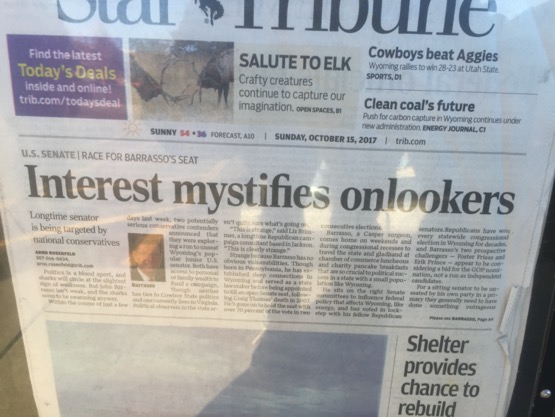
Oh....kay. Local Cheyenne headline.
The second day was a much shorter drive, across Wyoming and to Logan, Utah. We stopped en route at the Fossil Butte National Monument visitors center. They have a really impressive display of Green River fossils and casts. Definitely worth a visit, though it's a bit off the beaten path.
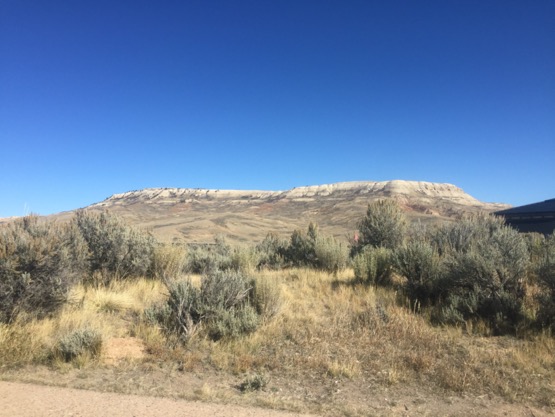
Fossil Butte, famous Eocene lacustrine deposts of the Green River Formation.
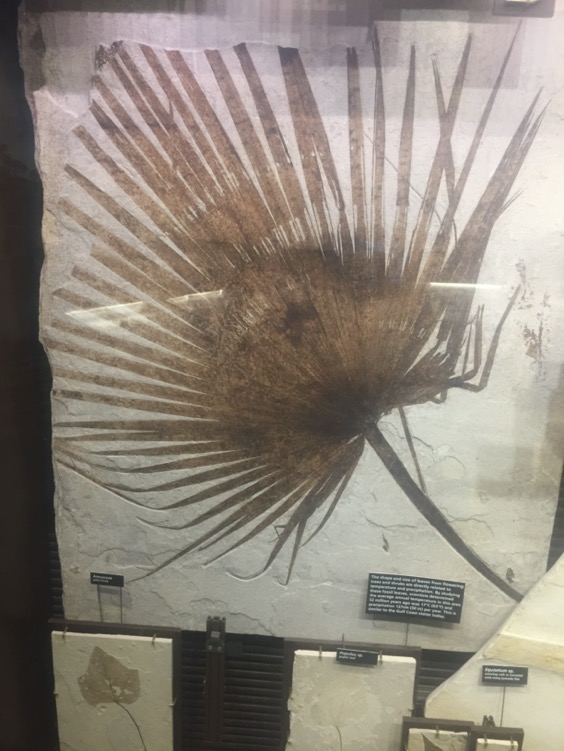
Eocene palm frond in the visistors center.
We arrived in Logan without incident, and on the Monday morning, we were ready to get started. There'd been a fair amount of snow visible at higher elevations on the way across Wyoming, so there was some worry that recent snowfall was going to mess us up. And it was also elk hunting season, so the woods were swarming with heavily armed manly men with beards, large trucks, ATVs, etc. We first thought it prudent to go to a big box store and by many orange things to wear. Talia felt that this allowed us to fit in better whenever we had to greet manly men. I pointed out that we weren't armed, which I'm pretty sure was a giveaway that we weren't Of Them.
We headed toward Hillyard Canyon by going east up Logan Canyon from Logan, then turning north on the Franklin Basin Road. Before too long we started seeing fairly freshly fallen snow. I was certain we'd get to the locality all right, but also that there was going to be some snow on the section. Our main target was locality HC6, which runs along the western ridge crest above the canyon. You access it via a little one lane track. I remember it as basically all right to travel, but it was in very rough shape, with some deep washed out ruts. With snow melting during daytime temperatures, it also turned into a quagmire. We got up it all right the first morning, parked where the road is closed to large vehicles, and got geared up. HC6 is one of the nastiest sections we work. It's a good distance from the section to where you have to leave the vehicles, and much of it is steeply uphill. It's not normal to have to carry packloads of rock uphill. The way in didn't bode well. Wet thin snowcover, rapidly melting and turning the track into mud. It was mostly still frozen on the way in, but it was pretty plain what it was going to be like carrying rock over the next couple of days.
We arrived at the top of the section and spent some time locating horizon HC6 226.5 m. This was one of the surprising new discoveries we made in 2011. It doesn't look like much on the surface, a microbialite with very sparse trilobites showing, but it yielded rich silicified material and turned out to represent the Heckethornia hyndeae Zone, which is otherwise unknown in the Garden City. We needed to get as much of it as we realistically could.
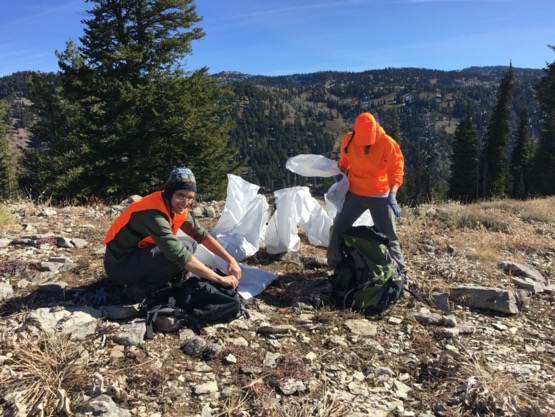
Reuben and Sarah getting ready for the first trip back from HC6 226.5 m.
Once we had the sampling area surrounded, I broke out Thor and the Gorilla Bar and got started. Thrombolites can be murder to collect as they are extremely dense and lack any bedding or cracks to break them up. This one was mercifully perfectly weathered, with lots of lumps sitting in place, and only a few huge blocks needing made smaller. We filled eleven heavy poly sacks of samples. Then Sarah and Reuben got busy doing what they'd mostly be doing for the next two days: acting like pack mules and ferrying the bulk rock samples back to the vehicles in their packs. Sarah had a little experience from our June trip to Ibex, but this was Reuben's debut. Everyone was jocular. Before they picked up packs full of rock.
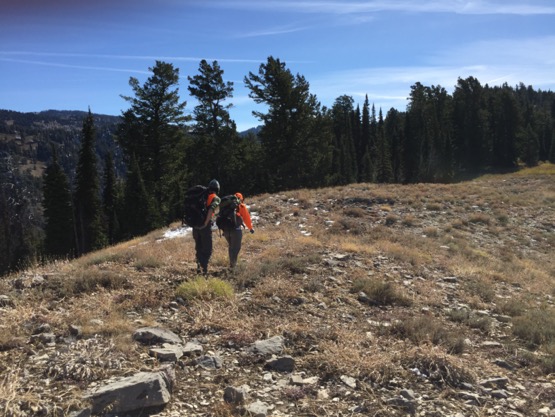
Reuben and Sarah set off on their first of I think eight round trips over the course of two days. Uphill. In mud and snow.
The next targets were horizons HC6 122.5 m and 124.0 m, also thrombolites, but down in the Stairsian. We also wanted to get isotope geochemistry samples across the end-Stairsian mass extinction interval to send to Steve Westrop down in Oklahoma. I was really worried about the boundary interval, as it's mostly covered and also facing east, so not likely to have gotten much sun. This turned out to be justified.
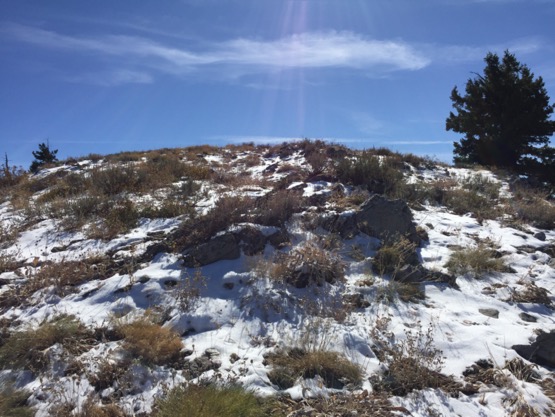
The Stairsian-Tulean boundary interval, mostly snow covered on the first day.
On our way down to the Stairsian we found a nice new horizon at HC6 195.0. There was a little bit of nice stuff in situ plus some talus lumps with articulated specimens on them. We wrapped the articulated ones in sample bags and took a small regular sample from the in situ. The boundary interval was mostly snow covered but it was melting fairly rapidly. We decided to make the remaining large collections first to give it as much time as possible. The thrombolites here weren't as nicely weathered, so there was a lot of swinging Thor and grunting bad language, but we got decent multi-sack samples out of both. It's comical when we go to these old horizons, sampled originally in 2000 or 2001. The sampling then was done by me with a little Estwing hand hammer. You can see exactly where I took the samples and they are typically maybe 1/20 of what we collect these days. While we were there I also wanted to drop down to HC6 58.4 m. This is the Rossaspis leboni Zone and I once collected a beautiful little sample here. Attempts since had involved rocks that didn't break down in acid. This time the little saddle was largely snow-covered, but we found one in situ bed with trilobites showing and pried out a heavy sackful.
By that point we had a whole bunch of rocks in sacks on the section, so the rest of the day was spent with all four of us making trips back to the vehicles.
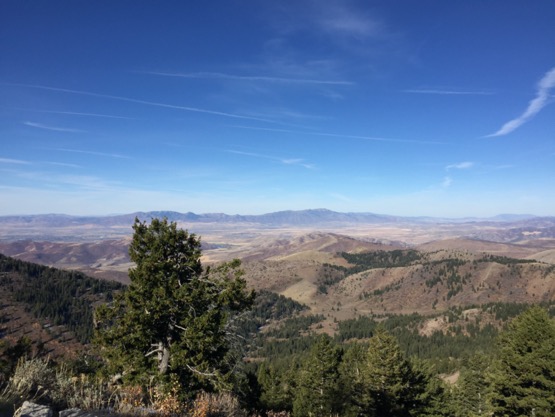
The view to the west from HC6 122.5 m.
The weather was sunny are relatively warm (highs around 60F, though lows at night well below freezing), so the snow continued to melt. On the second day we returned to HC6, facing even more of a quarmire. Sarah and Reuben again began hauling rock from the dwindling amount left on the section, while Talia and I headed for the boundary interval to make the geochem samples. The snow was markedly reduced from the day before, so we spent a few hours making the relatively small and closely spaced geochem samples, which we wrapped up in sample bags. Then we all hauled rock until it was completely done, which took us to mid-afternoon. There didn't seem enough time to do much of anything else, so we planned to retreat to Logan for a bit of rest. However one of the vehicles got badly stuck on the way out, amazingly stuck, biblically stuck, with the entire left side high centered. There was no way to get it out shy of a winch or tow, which we didn't have. Talia and I drove out to the first place we could find cell reception and called a back country tow service in Logan. It turned out to be a lengthy and expensive operation, but a highly competent young man came out and winched the vehicle out in the dark. We ended up not getting back to the hotel until nearly 10 pm.
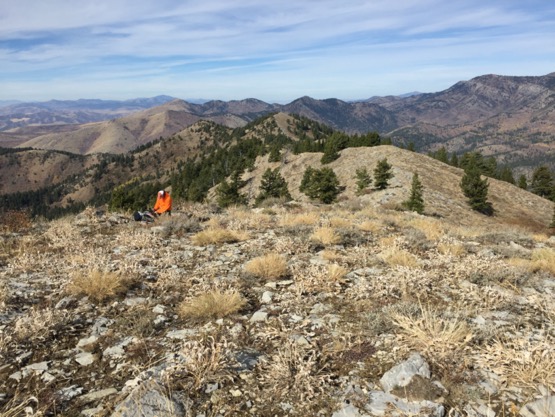
Talia making geochem samples in the mass extinction interval.
On the third and final day of fieldwork we went to the much flatter and less threatening FB7 in Franklin Basin, in order to try to re-sample some of the key upper Skullrockian horizons and include material both Sarah and Reuben are working on. This was trickier than anticipated, both because the section isn't marked with numbers in any way and my memory is no longer reliable after 16 or so years. I found what seemed like promising trilobite horizons in about four spots in the right part of the section, so hopefully we got it. We just labelled them as spot samples and took GPS readings for them. This section is a lot easier as it's nearly flat and you're within sight of the vehicles.
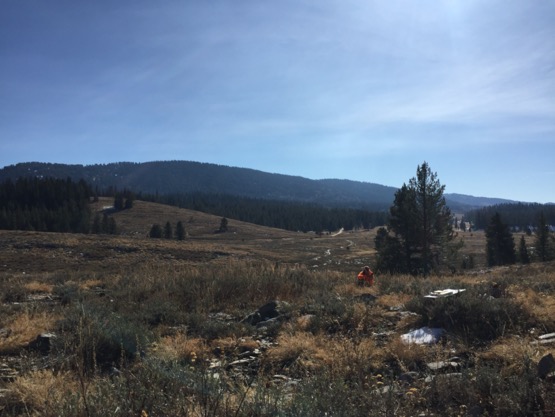
Sampling at Section FB7 at Franklin Basin.
With that, it was mission accomplished. I had originally hoped to work a day at HC5 but the road in the bottom of the canyon was very snowy and the lower part of HC5 was still snow covered when we left. We'd also needed all of the available time just to do what we'd managed. I took all of the rock back to Iowa City in my poor Jeep Compass, loaded so heavily that the rear wheelwells were almost scraping the tires, which Sarah and Reuben travelled in the other vehicle. We made it without any serious hassle, after stopping for the night in North Platte, Nebraska.